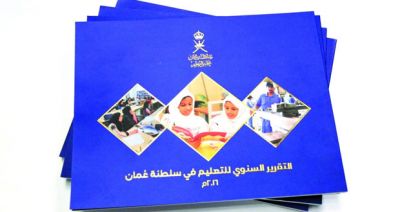
The Education Council released its annual education report for the year 2016. The report presents a general vision about the achievements of education sector so as to build on it and continue the development of this sector. The report also coincides with the implementation of programs and projects related to the Sultanate’s 9th five-year plan which mainly aim to diversify economy through developing 5 promising economic sectors, i.e. tourism, manufacturing, logistics, mining and fisheries as well as paying more attention to workforce and employment. Based on the main trends of such plan and projects which will be implemented in various sectors, education is the main platform for any sustainable economic development as the educational policies and projects are related to the general economic trends and derived from the recommendations of the National Strategy of Education in the Sultanate of Oman 2040.
The Annual Education Report 2016 presents the most important educational indicators in the sectors of pre-school education, school education and higher education which highlight achievements made by the Sultanate at the quantitative and qualitative levels compared to global standards especially in the area of enrollment in school education and higher education. The Report also reviews the most important projects carried out in the education sector during this year in general particularly in the area of entrepreneurship, innovation and scientific research and publishing. These projects resulted from policies and plans developed by the Education Council in pursuit of reaching the purposes intended for the continued qualitative development of the education system in the Sultanate.
The Report comprises 3 parts; Part One tackles the pre-school education and consists of 4 chapters: Chapter One is entitled: “Statistical Education Indicators about the pre-school education and school education” and starts with presenting statistical indicators about the pre-school education in terms of the net and total enrollment rate, number of kindergartens and preparation classrooms and the number of their students. This chapter also presents statistical indicators about the public school education and indicates the net and total enrollment rate and the number of students and schools in addition to annual growth rates, dropout and repetition rates, classroom density, teacher’s share of students and number of teaching and administrative staff and Omanization ratios. Chapter One also shows statistical indicators about the private school education and indicates the number of private schools, number of their enrolled students and number of their teachers in addition to statistical indicators about the continuing education as well as scientific research and publishing. As regards Chapter Two, it shows the most notable projects and programs of pre-school and school education which were implemented by the Ministry of Education during the year 2016, most importantly of which are: the project on expansion of educational robot laboratory, the project on preparation of the Omani-printed edition of the Qura’n and the project on creating smart applications to support school curricula. Chapter Three points out the aspects of innovation at the ministry’s level and student achievements in this field while Chapter Four shows the most important projects in the area of development of school education quality, particularly the two projects of; the General Framework for improvement of school education (2016-2040) and the Omani National Framework for the teaching profession.
Part Two of the 2016 annual education report deals with the higher education sector at its academic and technical levels in public and private higher education institutions. It comprises 4 chapters: Chapter One is entitled: Statistical Education Indicators about higher education and presents statistical indicators about the total enrollment rate and the number of newly accepted students, new students and students in all public and private higher education institutions whether inside the Sultanate or under the scholarship system along with annual growth rates. Chapter One also indicates statistical indicators about the number of non-Omani students and new students in public and private higher education institutions inside the Sultanate, number of graduates, student loss rate, academic performance rates, scientific research and publishing and other relevant indicators. Chapter Two of this part shows the most notable projects and programs of higher education implemented by public and private higher education institutions during the year 2016. These projects include: the national project to harmonize the outputs of higher education with the needs of the labor market in the Sultanate which was implemented by Sultan Qaboos University, the project on renovation of e-Education system in applied science colleges, the project on promotion of student self-learning and approval of open educational resources system in technical colleges, the project on health academic management for educational institutes, the project of summer training academy in the German University of Technology. Chapter Three of this part points out the aspects of innovation at the level of educational institutions and student achievements in this field. As regards Chapter Four entitled “Development of higher education quality”, it sums up the most important measures taken in the area of development of higher education quality at the level of the Oman Academic Accreditation Authority, the Ministry of Higher Education and educational institutions.
Part Three focuses on vocational education and training. It shows statistical education indicators about vocational education and training such as the number of students and trainees at institutes and centers of vocational education and training who are distributed according to the course, discipline and gender as well as the number of graduates and private training institutions. This part also tackles the most notable projects and programs of vocational education and training which were implemented during the year 2016. These projects include the project on the program supporting the training courses at the Vocational Training Center in Saham and the project on development of the Department of Horticulture at the same center. In addition, Part Three also points out the aspects of innovation at the level of institutes and centers, student achievements in this field and the quality development measures at the institutes and centers of vocational education and training.